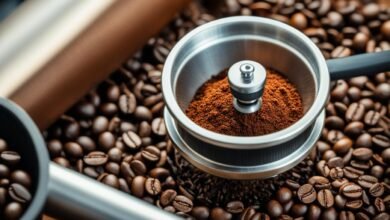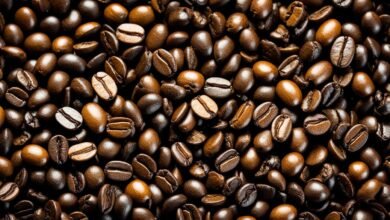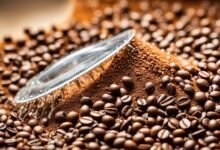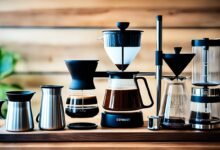The Ultimate Guide to Cold Brew Coffee

As the sun rises and the world comes to life, I’m drawn to the rich, smooth aroma of my morning coffee. Today, it’s not the usual hot brew in my mug – it’s the magical cold brew. This coffee has changed the game for caffeine lovers, and I’m excited to share its secrets with you.
In recent years, cold brew coffee has taken the world by storm, winning over coffee fans everywhere. It’s made differently, giving it a smooth and less acidic taste. Let’s explore the brewing process, its growing popularity, and the unique experience it brings with every sip.
Key Takeaways
- Cold brew coffee has less acidity and bitterness than traditional hot brewed coffee
- The cold brew process typically uses a 1:7 coffee to water ratio for a concentrated brew
- Freshly roasted and ground coffee is essential for achieving the best cold brew flavor
- Cold brew can be brewed through immersion or slow drip methods, each taking different amounts of time
- The cold brew concentrate can be diluted with various ingredients to create unique cold brew beverages
What is Cold Brew Coffee?
Cold brew coffee is a special way to make coffee. It gives you a smooth, less acidic, and sweeter taste than hot-brewed coffee. Cold brew coffee is made by soaking coffee grounds in cold or room-temperature water for 12 to 24 hours.
Definition and Brewing Process
This slow process extracts flavors from the coffee grounds. The result is a strong coffee concentrate. You then mix it with water or milk to make the cold brew drink. There are two main ways to make cold brew: immersion and slow drip.
- Immersion: This method involves soaking the coffee grounds in water for 12-24 hours. It makes a rich, smooth, and less acidic cold brew.
- Slow Drip: This method drips cold water over the coffee grounds slowly. It creates a delicate and nuanced cold brew over several hours.
| Brewing Method | Brewing Time | Flavor Profile |
|---|---|---|
| Immersion | 12-24 hours | Rich, smooth, less acidic |
| Slow Drip | Several hours | Delicate, nuanced |
Whether you use immersion or slow drip, cold brew coffee is known for its unique taste. It’s smooth, creamy, and refreshing. This makes it a great choice for coffee lovers.
“Cold brew coffee is a game-changer, offering a refreshing and low-acid alternative to traditional hot-brewed coffee.”
The Rise of Cold Brew Popularity
In recent years, cold brew coffee has become a big hit, becoming a top trend in the specialty coffee world. It’s growing by 25% each year and is expected to hit $1.63 billion by 2025.
Several factors have made cold brew popular. Its smooth taste, with low acidity, has won over coffee lovers. It’s made by soaking coffee beans in cold water for 12 to 24 hours. This gives it a unique flavor that’s sweeter and more chocolatey than hot coffee.
Cold brew is also versatile, making it a favorite in many drinks. It’s perfect for hot days and fits well with the growing love for specialty coffee. People enjoy it as a way to taste high-quality coffee in a new way.
Now, cold brew is a big hit worldwide, moving from a niche drink to a favorite among coffee fans.
| Cold Brew Coffee Concentrate Ratio | Brewing Time | Grind Size | Storage |
|---|---|---|---|
| 25 grams of ground coffee to 1 cup of filtered water | 18 hours (variations between 12-24 hours) | Medium coarse | Up to 1 week in the refrigerator |

“Many people prefer cold brew coffee due to its smooth, less acidic taste compared to iced coffee or hot coffee, making it ideal for black coffee consumption during the daytime.”
Cold brew coffee is also seen as a healthier option. Studies suggest that drinking one cup a day can lower heart disease risk. It’s also less acidic than hot coffee, making it gentler on the stomach.
Flavor Profile and Smoothness
Cold brew coffee is known for its smooth, low-acidity taste. It gets this from steeping longer and using cold water. This process pulls out fewer bitter compounds and acidic oils. So, it tastes sweeter and more natural than hot coffee.
It has up to 65% less acidity and bitterness than hot coffee. This makes cold brew gentler on the stomach. It’s perfect for those who find hot coffee too harsh.
The smooth, creamy texture and sweet taste let the coffee beans’ unique flavors stand out. This gives a unique taste experience unlike hot coffee.
Understanding the Reduced Acidity and Bitterness
Cold brew coffee steeps for 12-24 hours with a 1:8 coffee-to-water ratio. This slow steep and cold water make it less acidic and bitter. It’s different from hot coffee’s quick infusion.
For cold brew, medium to dark roasts work best. They bring out sweetness and reduce bitterness. Plus, cold brew can stay fresh for two weeks in the fridge, keeping its smooth taste.
“The smooth, creamy body and pronounced sweetness of cold brew also allow the unique flavor notes of the coffee beans to shine through, offering a distinct taste experience compared to hot brewed coffee.”

Cold Brew, Ultimate Guide, Coffee
Explore the world of cold brew coffee with our ultimate guide! Cold brew has become a hit, loved for its smooth, rich taste and less acidity. We’ll cover how to make perfect cold brew at home.
Cold brew coffee is made by steeping grounds in cold water for 12-24 hours. Use a coarse grind, like for a French press. This method creates a strong brew that mixes well with water or milk for a tasty iced coffee.
For the best cold brew, think about getting a cold brew maker. The Hario USA “Mizudashi” model is a top choice, costing $22.50 and holding 1000ML. Or, the Ovalware Cold Brew Maker is great for small groups, with a 64-ounce capacity.
Choosing the right coffee blend is key. Try the 48 coffee blend from cartelroasting.co for its smooth, rich taste. It’s perfect for cold brew.
For the best brew, mix one cup of cold water with two ounces of coffee grounds. Let it sit in the fridge for 48 hours for the best flavor. This ensures a refreshing cold brew.

This guide is perfect for both cold brew experts and beginners. Discover the art of cold brewing, its flavors, and health benefits. Start your cold brew coffee adventure today!
Brewing Methods: Immersion vs. Slow Drip
There are two main ways to make perfect cold brew coffee: immersion and slow drip. Each method gives a unique taste and needs different time and tools. This makes each one good for different tastes and setups.
The immersion method dips ground coffee in cold water and lets it steep for 12-24 hours. This makes a full-bodied coffee with a smooth taste. You only need a few simple tools, making it great for beginners or those with little space.
The slow drip method drips cold water over coffee grounds for 6-12 hours. This method creates a strong, bright-tasting coffee. You’ll need a special machine, but it brings out the coffee’s unique flavors.
| Brewing Method | Brewing Time | Flavor Profile | Equipment Needed |
|---|---|---|---|
| Immersion | 12-24 hours | Full-bodied, mellow, smooth | Minimal (e.g., French press, mason jar) |
| Slow Drip | 6-12 hours | Concentrated, crisp, bright | Specialized (e.g., cold brew maker) |
Choosing between immersion and slow drip cold brew depends on what you like, the taste you want, and what you have. Both are refreshing and have less acidity than hot coffee. They let coffee lovers try out cold brew and find their favorite way to make it.
Equipment and Ingredients
To make perfect cold brew coffee at home, you need some key equipment and quality ingredients. You can use a simple mason jar or a special cold brew maker like the Toddy Cold Brew System or the Hario Mizudashi. Make sure to clean and sanitize your brewing vessel before use to avoid bacteria.
For the coffee, use beans that are freshly roasted. Aim for a coarse to medium-coarse grind size for the best extraction. A burr grinder is best for a consistent grind. Use filtered or bottled water for the best flavor.
Experimenting with Coffee Beans
Feel free to try different coffee origins and roast levels to find your ideal cold brew. Experiment with various types, like cold brew, to find what you like best. Cold brewing can reveal unique flavors not found in hot-brewed coffee.
- Freshly roasted coffee beans
- Coarse to medium-coarse grind size
- Burr grinder for consistent grind
- Filtered or bottled water
“Cold brew coffee can last up to a week in the fridge without going bad, allowing you to experiment with different ratios and bean types.”
Great cold brew requires patience and careful attention. With the right gear and ingredients, you can make a smooth, rich coffee that’s less acidic and more enjoyable.

Brew Ratios and Dilution
Making the perfect cold brew means getting the brew ratio right. This is the mix of coffee grounds to water. For regular hot coffee, use 1 gram of coffee for every 15-18 milliliters of water. But, cold brew concentrates use a stronger mix, from 1:2 to 1:5.
To get a smooth taste, you’ll need to dilute the cold brew concentrate. Mix 1 part concentrate with 4 to 6 parts water, milk, or other liquids. This makes the drink 1:10 to 1:14, which is perfect. Try different ratios to find what you like best.
| Brew Type | Typical Ratio |
|---|---|
| Regular Hot Coffee | 1:15 to 1:18 |
| Cold Brew Concentrate | 1:2 to 1:5 |
| Diluted Cold Brew | 1:10 to 1:14 |
Remember these ratios to make a cold brew that’s just right. Use a kitchen scale for accurate measurements. With some trial, you’ll soon enjoy a smooth and tasty cold brew.
“The key to a great cold brew is finding the right balance through careful attention to the brew ratio and dilution.”
Serving and Enjoying Cold Brew
Cold brew coffee is more than just a drink on its own. You can mix it with water, milk, or other liquids to make refreshing drinks. For a simple iced coffee, mix cold brew concentrate with water or milk over ice.
Or, try a cold brew latte by adding steamed milk. For a twist, mix it with soda water and a bit of sweetener for a cold brew soda.
Cold brew is great for making caffeinated cocktails too. Try a cold brew old fashioned or a cold brew negroni. You can get creative and enjoy the smooth, bold taste of cold brew coffee in many ways.
Recipes and Variations
Here are some tasty ways to serve and enjoy your cold brew:
- Classic Iced Cold Brew: Mix equal parts cold brew concentrate and water or milk over ice for a refreshing iced coffee.
- Cold Brew Latte: Combine cold brew concentrate with steamed milk for a creamy, indulgent latte.
- Cold Brew Soda: Mix cold brew concentrate with soda water and a touch of sweetener for a unique caffeinated soda.
- Cold Brew Cocktails: Use cold brew concentrate as a base for cocktails like a cold brew old fashioned or a cold brew negroni.
| Beverage | Ingredients | Ratio |
|---|---|---|
| Iced Cold Brew | Cold Brew Concentrate, Water, Ice | 1:1 |
| Cold Brew Latte | Cold Brew Concentrate, Steamed Milk | 1:1 |
| Cold Brew Soda | Cold Brew Concentrate, Soda Water, Sweetener | 1:2, Sweetener to taste |
| Cold Brew Old Fashioned | Cold Brew Concentrate, Bourbon, Bitters, Orange Peel | 2:1 Concentrate to Bourbon |
“The world is your cold brew oyster when it comes to enjoying this versatile beverage.”
Health Benefits and Considerations
Cold brew coffee is more than just tasty; it’s also good for your health. It has less acidity than hot coffee, making it easier on the stomach. This is great for people who can’t handle high acidity.
The way cold brew is made keeps more of the coffee’s antioxidants. These antioxidants can help prevent obesity, diabetes, and other serious diseases. They support your overall health.
Cold brew also has more caffeine than hot coffee. This can give you a big energy boost and help you focus. But, if you’re watching your caffeine intake, you might want to be careful.
- Cold brew coffee is about 67% less acidic than hot coffee, making it gentler on the stomach.
- The cold brewing process helps keep more of the coffee’s antioxidants, which can lower disease risk.
- Cold brew usually has more caffeine, giving you a strong energy boost, but be careful if you’re sensitive to caffeine.
It’s important to watch how much cold brew you drink and stay hydrated. Think about the good points and what you need to consider. This way, you can enjoy cold brew without worrying about your health.
“Cold brew coffee is suspected to preserve the beneficial components of coffee beans, including phytonutrients, fatty acids, and antioxidants better than traditional coffee due to less heat exposure.”
Conclusion
This guide has taken you through the world of cold brew coffee. We covered its definition, brewing process, and why it’s getting more popular. We talked about its unique flavor profile and smoothness.
We also looked at the different ways to make it at home. We discussed the equipment and ingredients you need for the perfect cup. Plus, we touched on the health benefits and how versatile cold brew can be in various drinks and cocktails.
If you’re new to cold brew or a long-time fan, this guide has everything you need. It’s your key to enjoying specialty coffee like never before. You’ll learn about the best brew ratio, dilution methods, and artisanal roasts.
Now, you’re ready to start your own cold brew coffee adventure. Try out different flavors and techniques to find what you like best. Dive into the world of cold brew and take your coffee experience to the next level.






